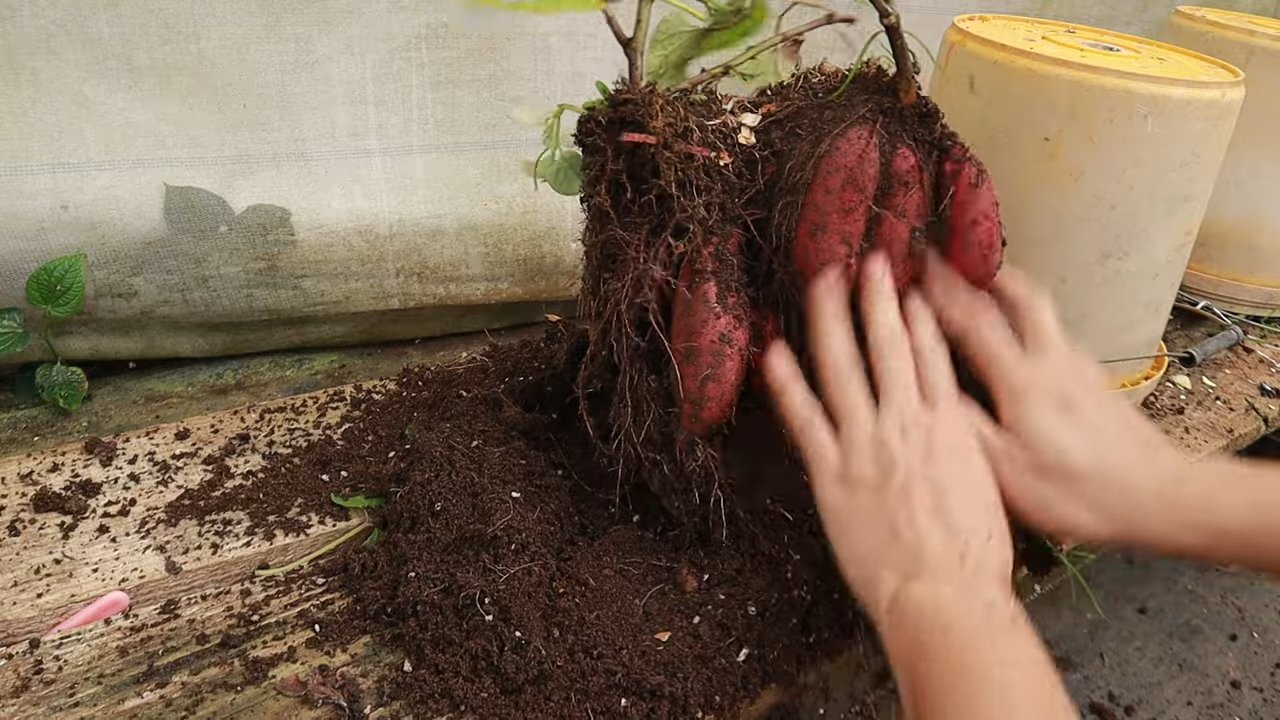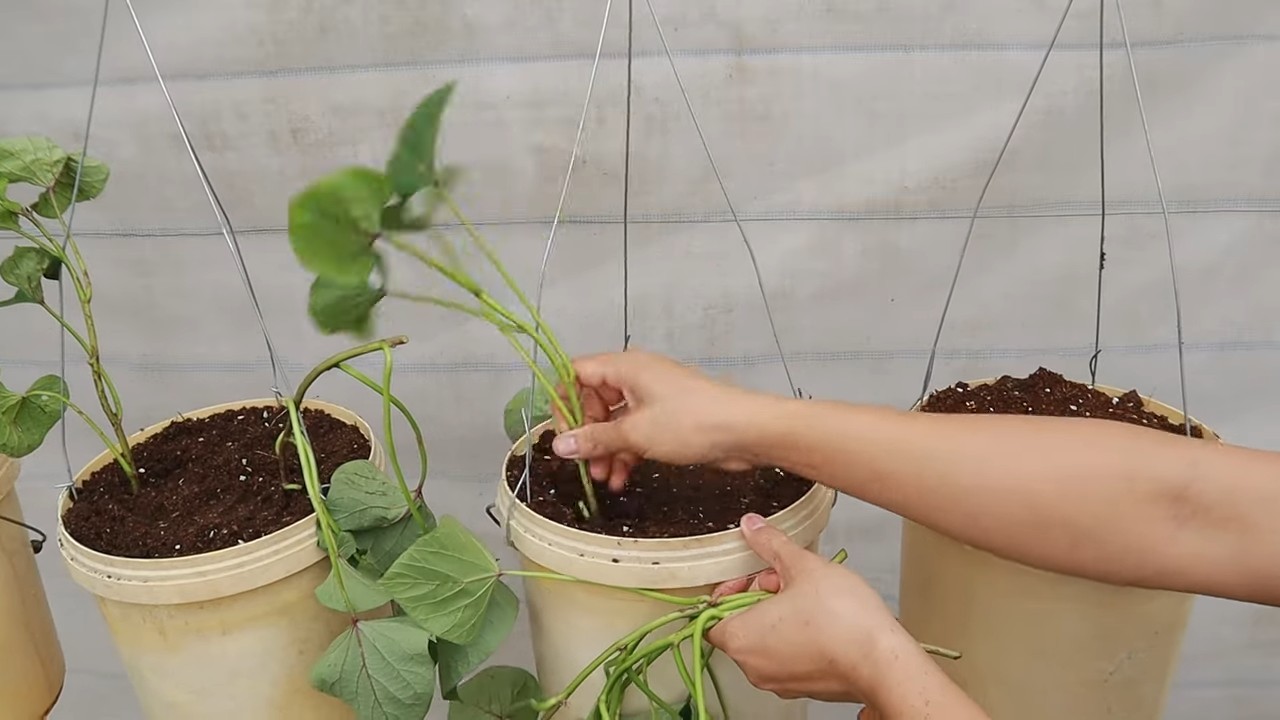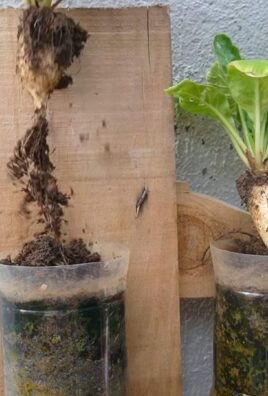Sweet Potato Vertical Garden: Imagine harvesting a bounty of delicious sweet potatoes from a space no bigger than a small balcony! Sounds too good to be true? It’s not! I’m thrilled to share a fantastic DIY project that will revolutionize your gardening game: building your very own sweet potato vertical garden.
For centuries, sweet potatoes have been a staple crop in many cultures, providing essential nutrients and a comforting sweetness. From the indigenous peoples of South America, where they originated, to their widespread cultivation across Asia and Africa, sweet potatoes have nourished generations. Now, we’re taking this ancient food source and giving it a modern, space-saving twist!
In today’s world, many of us are limited by space, making traditional gardening a challenge. But that shouldn’t stop you from enjoying the satisfaction of growing your own food. That’s where this DIY sweet potato vertical garden comes in. It’s the perfect solution for apartment dwellers, urban gardeners, or anyone looking to maximize their yield in a small area. Plus, it’s a fun and rewarding project that will impress your friends and family. Get ready to learn how to create a thriving sweet potato vertical garden that will provide you with a delicious and sustainable harvest!

Sweet Potato Vertical Garden: Your DIY Guide for a Bountiful Harvest in a Small Space
Hello garden friends! Do you also have very little space but still want a bountiful harvest? Then I have just the thing for you: a sweet potato vertical garden! It’s not only space-saving but also a real eye-catcher. And the best part: it’s super easy to build yourself. Let’s get started!
What you need for your sweet potato vertical garden:
Here is a list of all the materials and tools you will need for this project. Don’t worry, you probably have many of them at home already!
- Planters: I recommend several medium to large pots or grow bags. They should be at least 30 cm in diameter so the sweet potatoes have enough space to grow.
- Soil: High-quality potting soil is essential. You can also mix in compost to improve the nutrient supply.
- Sweet potato slips: You can get these at a garden center or online. Make sure they look healthy and strong. You can also use sweet potatoes from the supermarket to grow your own slips (more on that later!).
- Bamboo stakes or a trellis: Sweet potatoes are climbing plants, so they need a climbing support. Bamboo stakes are inexpensive and look good.
- Watering can or garden hose: For watering your plants.
- Scissors or knife: For trimming the vines if necessary.
- Optional: Mulch (e.g., straw or wood chips) to cover the soil and retain moisture.
- Optional: Fertilizer (organic or mineral) for an optimal supply of nutrients.
Step-by-Step Guide: How to Build Your Vertical Garden
Now let’s get down to it! Follow these steps to build your own sweet potato vertical garden.
1. The Preparation:
- Choose the right location: Sweet potatoes love the sun! Find a sunny spot in your garden or on your balcony. The location should get at least 6 hours of direct sunlight per day.
- Prepare the planters: Make sure your pots or grow bags have drainage holes so that excess water can run off. This prevents waterlogging, which sweet potatoes do not like at all.
- Fill the planters with soil: Fill the pots or bags about two-thirds full with soil. Press the soil down lightly.
2. Planting the Sweet Potato Slips:
- Loosen the roots: Carefully remove the slips from their pots and loosen the roots a little. This helps them to root better in the new soil.
- Plant the slips: Place the slips in the prepared pots. Make sure the roots are well covered with soil. The distance between the slips should be about 30-40 cm.
- Water the slips: Water the slips thoroughly after planting. This helps the soil to settle around the roots.
3. Installing the Climbing Support:
- Place the bamboo stakes or trellis: Stick the bamboo stakes into the soil, close to the slips. Alternatively, you can place a trellis behind the pots.
- Guide the vines: As the sweet potato plants grow, gently guide their vines along the bamboo stakes or trellis. You can secure them with some garden wire or string if necessary.
4. Caring for Your Sweet Potato Vertical Garden:
- Watering: Sweet potatoes need regular watering, especially during the hot summer months. Water them when the top layer of soil feels dry. Avoid waterlogging!
- Fertilizing: Fertilize your sweet potatoes every few weeks with an organic or mineral fertilizer. Pay attention to the dosage instructions on the packaging.
- Mulching: Cover the soil around the plants with mulch (e.g., straw or wood chips). This helps to retain moisture in the soil and suppress weeds.
- Pruning: Prune long vines back if necessary to encourage the plant to form more tubers.
Growing Your Own Sweet Potato Slips: Here’s How!
Do you want to grow your own slips? No problem! It’s easier than you think.
1. Preparing the Sweet Potato:
- Choose a healthy sweet potato: At the supermarket, look for a firm, undamaged sweet potato.
- Halve the sweet potato (optional): You can halve the sweet potato to get more slips.
2. Placing the Sweet Potato in Water:
- Insert toothpicks into the sweet potato: Insert three or four toothpicks into the middle of the sweet potato so that it can sit horizontally in the water.
- Place the sweet potato in a glass of water: Fill a glass with water and place the sweet potato in it so that the lower half is in the water.
- Place the glass in a bright place: Place the glass in a bright, warm place, but not in direct sun.
3. Waiting and Observing:
- Change the water regularly: Change the water every few days to prevent rot.
- Wait for the shoots: After a few weeks, shoots should form on the sweet potato.
- When the shoots have roots: As soon as the shoots are about 10-15 cm long and have their own roots, you can carefully break or cut them off the sweet potato.
4. Planting the Shoots:
- Plant the shoots in small pots: Plant the shoots in small pots with potting soil.
- Water the shoots: Water the shoots thoroughly after planting.
- Care for the shoots: Place the pots in a bright place and keep the soil moist. After a few weeks, the shoots are ready to move into your vertical garden.
The Harvest: When is the Time?
The harvest time for sweet potatoes is usually in the fall, just before the first frost.
- Look at the leaves: When the leaves turn yellow and die back, it’s a sign that the sweet potatoes are ripe.
- Dig carefully: Carefully dig the sweet potatoes out of the soil. Be careful not to damage the tubers.
- Let the sweet potatoes dry: After harvesting, let the sweet potatoes dry for a few days in a dry, airy place. This cures the skin and improves storage life.
Tips and Tricks for a Successful Harvest:
Watch out for pests: Sweet potatoes can be infested by various pests, such as aphids or slugs. Check your plants regularly and combat pests with natural methods if necessary.
Choose the right variety: There are different varieties of sweet potatoes. Find out which variety is best for your climate and growing conditions.

Conclusion
So, there you have it! Transforming a humble sweet potato into a thriving vertical garden is not just a fun project; it’s a rewarding experience that brings a touch of nature indoors (or out!). We’ve walked you through the simple steps, highlighting the ease and accessibility of this DIY trick. But why is this a must-try?
Firstly, it’s incredibly budget-friendly. You’re likely to have most of the materials already lying around – a sweet potato, some toothpicks, a jar or glass, and water. The initial investment is minimal, making it a fantastic project for families, classrooms, or anyone looking for a low-cost gardening adventure.
Secondly, it’s a fantastic educational opportunity. Witnessing the sweet potato sprout and develop roots is a captivating lesson in botany. It’s a tangible way to understand plant growth, root systems, and the power of nature. Kids, in particular, will be mesmerized by the process, fostering a love for gardening and science.
Thirdly, it’s a unique and eye-catching decorative element. Forget generic houseplants; a sweet potato vertical garden is a conversation starter. Its cascading vines and vibrant green leaves add a touch of whimsy and natural beauty to any space. It’s a living piece of art that you created yourself!
But the benefits don’t stop there. This project is also incredibly adaptable. Want to add a personal touch? Consider painting the jar or glass with vibrant colors or adding decorative stones to the bottom. You can even experiment with different varieties of sweet potatoes to see which ones produce the most impressive foliage.
Variations to Explore:
* The Herb Garden Hybrid: Once your sweet potato has established a strong root system, consider adding small herb cuttings to the water. Mint, basil, or even rosemary can thrive alongside the sweet potato, creating a fragrant and functional vertical garden.
* The Hydroponic Twist: For a more advanced approach, research hydroponic nutrients and add them to the water. This will provide your sweet potato with a more balanced diet, potentially leading to even more vigorous growth.
* The Outdoor Oasis: While this project is perfect for indoors, it can also thrive outdoors in a shaded area. Just be sure to protect it from extreme temperatures and direct sunlight.
We wholeheartedly encourage you to give this DIY trick a try. It’s a simple, affordable, and rewarding way to connect with nature and add a touch of green to your life. And most importantly, don’t forget to share your experience! We’d love to see your sweet potato vertical gardens in action. Post photos and videos on social media using #SweetPotatoGarden and tag us so we can admire your creations and share them with our community. Let’s spread the joy of gardening, one sweet potato at a time!
Frequently Asked Questions (FAQ)
How long does it take for a sweet potato to sprout roots?
Generally, you should start seeing roots emerge within 1-2 weeks. However, this can vary depending on the variety of sweet potato, the temperature of the water, and the amount of light it receives. Warmer temperatures and indirect sunlight tend to encourage faster root growth. Be patient, and make sure to change the water every few days to prevent bacterial growth. If you don’t see any action after three weeks, try a different sweet potato.
What kind of sweet potato should I use?
Any variety of sweet potato will work, but organic sweet potatoes are often recommended as they are less likely to have been treated with growth inhibitors. Look for sweet potatoes that are firm, smooth, and free from blemishes or soft spots. Smaller to medium-sized sweet potatoes are generally easier to manage in a jar or glass.
How often should I change the water?
It’s important to change the water every 2-3 days to prevent the growth of bacteria and algae. Stagnant water can lead to root rot and other problems. When you change the water, gently rinse the sweet potato and the jar or glass to remove any buildup.
What kind of light does my sweet potato vertical garden need?
Sweet potatoes need bright, indirect sunlight to thrive. Avoid placing your vertical garden in direct sunlight, as this can scorch the leaves. A spot near a window that receives morning or afternoon sun is ideal. If you don’t have access to natural light, you can supplement with a grow light.
Can I plant the sweet potato in soil after it sprouts?
Yes, you can definitely transplant your sweet potato to soil once it has developed a strong root system and several healthy vines. Choose a large pot with well-draining soil. Gently remove the sweet potato from the water and plant it in the pot, burying the roots and the bottom portion of the sweet potato. Water thoroughly and place the pot in a sunny location. Keep the soil moist but not soggy.
Will my sweet potato produce more sweet potatoes?
While it’s possible for your sweet potato to produce more sweet potatoes, it’s not very likely in a vertical garden setting. Sweet potatoes typically need a lot of space and specific growing conditions to produce tubers. However, you can enjoy the beautiful foliage and the satisfaction of growing your own plant.
The leaves on my sweet potato are turning yellow. What’s wrong?
Yellowing leaves can be a sign of several problems, including overwatering, underwatering, lack of nutrients, or pest infestation. Check the soil moisture to ensure it’s not too wet or too dry. If the soil seems fine, consider adding a diluted liquid fertilizer to the water to provide essential nutrients. Inspect the leaves for any signs of pests, such as aphids or spider mites. If you find pests, treat the plant with an appropriate insecticide.
My sweet potato isn’t sprouting. What should I do?
If your sweet potato isn’t sprouting after a few weeks, there are a few things you can try. First, make sure the water is warm and that the sweet potato is receiving enough light. You can also try scoring the sweet potato with a knife to encourage sprouting. Simply make a few shallow cuts around the middle of the sweet potato. Finally, you can try using a different sweet potato. Sometimes, certain sweet potatoes are simply not viable.
Can I use tap water for my sweet potato vertical garden?
While tap water is generally safe to use, it’s best to let it sit out for 24 hours before using it to allow the chlorine to evaporate. Alternatively, you can use filtered water or rainwater.
Is this project safe for pets?
Sweet potato vines are generally considered non-toxic to pets, but it’s always best to keep them out of reach to prevent them from chewing on the leaves or roots. Ingesting large quantities of plant material can cause digestive upset in some animals.




Leave a Comment